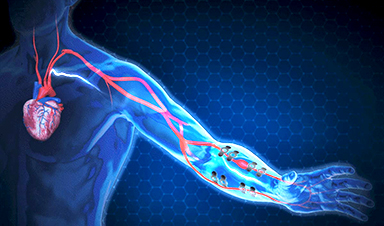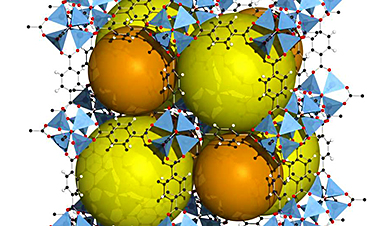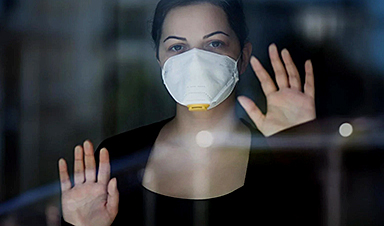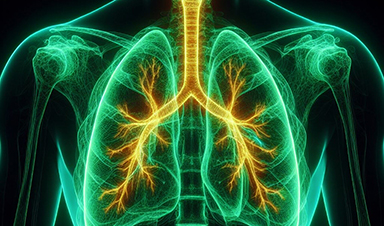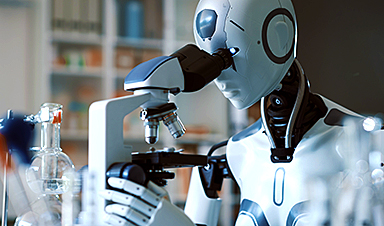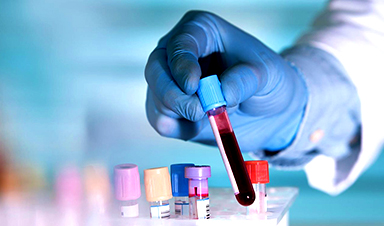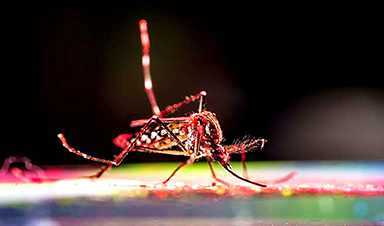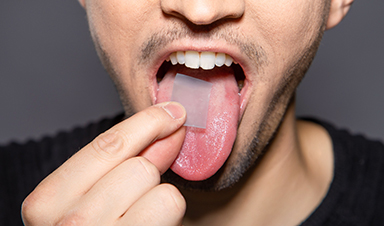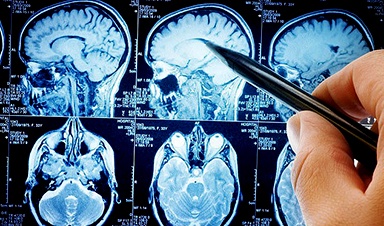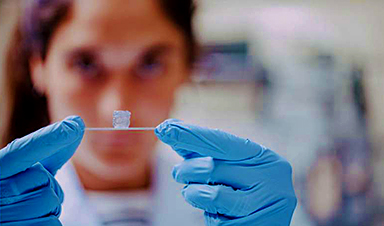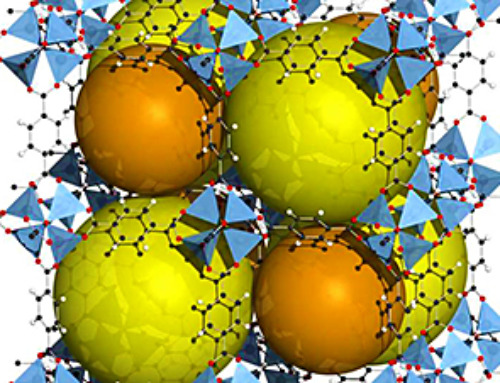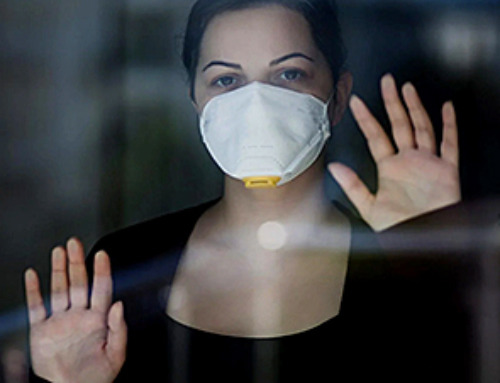| Blood pressure is a key vital sign that provides insight into our cardiovascular health. But blood pressure is typically measured only a few times per year by a clinician—and these measurements might not always be accurate (maybe, for instance, you’re nervous at the doctor’s office). A wearable device that could monitor blood pressure continuously would provide more informative readings, allowing clinicians to observe trends and detect consequential blood pressure changes, ultimately improving heart health. | |
| Nearly a decade ago, in collaboration with the Indian government, NIBIB spearheaded an international effort to develop a wearable cuffless system. Building on years of research, scientists are now fine-tuning such a device. Made of graphene, one of the thinnest materials in the world, the device is worn on the underside of the wrist and can measure blood pressure with comparable accuracy to a standard blood pressure cuff. While the technology is still in its early stages, the researchers envision that the monitor will be worn 24/7. | |
| The device was recently described in Nature Nanotechnology (“Continuous cuffless monitoring of arterial blood pressure via graphene bioimpedance tattoos”). |
| “The blood pressure monitor was developed in the late 19th century, and the core technology has not seen significant changes,” explained Tiffani Lash, Ph.D., a program director in the Division of Health Informatics Technologies at NIBIB. “Unlike traditional blood pressure cuffs, this device could enable continuous and unobtrusive monitoring, which could pave the way for remote, round-the-clock evaluation of blood pressure. As cardiovascular diseases are the leading cause of mortality worldwide, such a device has the capacity to mitigate potentially preventable deaths.” | |
| At first glance, the blood pressure monitor looks like a temporary tattoo—the graphene and the tiny components inside resemble small, transparent stickers, which adhere directly to the skin. The application is even similar: place the device—which is attached to a thin strip of paper—onto the skin, dampen the paper with water, and gently remove the paper, leaving the blood pressure monitor behind. | |
| Similar ‘electronic tattoos’ have been investigated before, but they typically employ metal films that do not conform perfectly to the skin, explained study author Deji Akinwande, Ph.D., a professor at The University of Texas at Austin. “With prior devices, there’s a lot of sliding between the metal film and the skin, leading to motion artifacts that can mask the real signal that we’re trying to capture,” he said. “Because graphene is so thin and flexible, it doesn’t suffer from motion artifacts, and we can capture precise measurements for an extended period of time.” | |
| The tattoos don’t measure blood pressure directly, like traditional monitors do. Instead, the tattoos rely on bioimpedance—a measure of how the body resists an electrical current. The tattoos contain tiny electrodes that apply a small current to an artery in the wrist and then sense how that current is affected by the artery. These bioimpedance measurements can then be converted into blood pressure readings using machine learning. | |
| The researchers evaluated their bioimpedance tattoos in seven healthy individuals. On average, each participant was continuously monitored for about four hours, resulting in roughly 2,000 measurements per participant. Participants performed various exercises to intentionally raise their blood pressure, such as completing hand grip exercises, peddling on a stationary bike, or performing the Valsalva maneuver (when one attempts to forcefully exhale when their mouth is closed and their nose is pinched shut). During these experiments, participants also wore a medical-grade blood pressure monitor to provide reference blood pressure measurements—and the researchers found that their bioimpedance tattoos could determine participants’ blood pressure with high accuracy. | |
| The researchers next evaluated the ability of their system to calculate blood pressure readings for circumstances beyond those assessed in their initial experiments. Participants were then invited to perform additional activities—like walking or engaging in strenuous exercise (such as an extensive, sweat-inducing outdoor walk or pushups). Following these activities, the researchers evaluated blood pressure readings (which are taken when participants are stationary). While the bioimpedance tattoos could withstand exposure to light, heat, water, or sweat, their blood pressure accuracy decreased slightly during post-exercise monitoring. The researchers will continue to incorporate additional data, including higher blood pressure measurements induced by exercise, into their machine learning algorithms—which should enhance their accuracy. | |
| The researchers also envision further optimization of their device so that the blood pressure data could be wirelessly transmitted. As of now, the tattoos require connection to external equipment using thin gold wiring, which enables a blood pressure readout. | |
| “This first-generation device is still in its early stages, but the promise of this technology is that it could literally be worn at all times and provide a wealth of biophysical data,” said study author Roozbeh Jafari, Ph.D., a professor at Texas A&M University and lead author on the NIBIB grant. “Blood pressure and hypertension are tied to serious and life-threatening health conditions, and the ability to monitor this vital sign continuously could inform proactive interventions that could improve public health.” | |
| And as research indicates that blood pressure levels have increased during the pandemic, finding ways to monitor blood pressure continuously, especially among those with hypertension, may become increasingly important. |
News
Scientists Begin $14.2 Million Project To Decode the Body’s “Hidden Sixth Sense”
An NIH-supported initiative seeks to unravel how the nervous system tracks and regulates the body’s internal organs. How does your brain recognize when it’s time to take a breath, when your blood pressure has [...]
Scientists Discover a New Form of Ice That Shouldn’t Exist
Researchers at the European XFEL and DESY are investigating unusual forms of ice that can exist at room temperature when subjected to extreme pressure. Ice comes in many forms, even when made of nothing but water [...]
Nobel-winning, tiny ‘sponge crystals’ with an astonishing amount of inner space
The 2025 Nobel Prize in chemistry was awarded to Richard Robson, Susumu Kitagawa and Omar Yaghi on Oct. 8, 2025, for the development of metal-organic frameworks, or MOFs, which are tunable crystal structures with extremely [...]
Harnessing Green-Synthesized Nanoparticles for Water Purification
A new review reveals how plant- and microbe-derived nanoparticles can power next-gen water disinfection, delivering cleaner, safer water without the environmental cost of traditional treatments. A recent review published in Nanomaterials highlights the potential of green-synthesized nanomaterials (GSNMs) in [...]
Brainstem damage found to be behind long-lasting effects of severe Covid-19
Damage to the brainstem - the brain's 'control center' - is behind long-lasting physical and psychiatric effects of severe Covid-19 infection, a study suggests. Using ultra-high-resolution scanners that can see the living brain in [...]
CT scan changes over one year predict outcomes in fibrotic lung disease
Researchers at National Jewish Health have shown that subtle increases in lung scarring, detected by an artificial intelligence-based tool on CT scans taken one year apart, are associated with disease progression and survival in [...]
AI Spots Hidden Signs of Disease Before Symptoms Appear
Researchers suggest that examining the inner workings of cells more closely could help physicians detect diseases earlier and more accurately match patients with effective therapies. Researchers at McGill University have created an artificial intelligence tool capable of uncovering [...]
Breakthrough Blood Test Detects Head and Neck Cancer up to 10 Years Before Symptoms
Mass General Brigham’s HPV-DeepSeek test enables much earlier cancer detection through a blood sample, creating a new opportunity for screening HPV-related head and neck cancers. Human papillomavirus (HPV) is responsible for about 70% of [...]
Study of 86 chikungunya outbreaks reveals unpredictability in size and severity
The symptoms come on quickly—acute fever, followed by debilitating joint pain that can last for months. Though rarely fatal, the chikungunya virus, a mosquito-borne illness, can be particularly severe for high-risk individuals, including newborns and older [...]
Tiny Fat Messengers May Link Obesity to Alzheimer’s Plaque Buildup
Summary: A groundbreaking study reveals how obesity may drive Alzheimer’s disease through tiny messengers called extracellular vesicles released from fat tissue. These vesicles carry lipids that alter how quickly amyloid-β plaques form, a hallmark of [...]
Ozone exposure weakens lung function and reshapes the oral microbiome
Scientists reveal that short-term ozone inhalation doesn’t just harm the lungs; it reshapes the microbes in your mouth, with men facing the greatest risks. Ozone is a toxic environmental pollutant with wide-ranging effects on [...]
New study reveals molecular basis of Long COVID brain fog
Even though many years have passed since the start of the COVID-19 pandemic, the effects of infection with SARS-CoV-2 are not completely understood. This is especially true for Long COVID, a chronic condition that [...]
Scientists make huge Parkinson’s breakthrough as they discover ‘protein trigger’
Scientists have, for the first time, directly visualised the protein clusters in the brain believed to trigger Parkinson's disease, bringing them one step closer to potential treatments. Parkinson's is a progressive incurable neurological disorder [...]
Alpha amino acids’ stability may explain their role as early life’s protein building blocks
A new study from the Hebrew University of Jerusalem published in the Proceedings of the National Academy of Sciences sheds light on one of life's greatest mysteries: why biology is based on a very specific set [...]
3D bioprinting advances enable creation of artificial blood vessels with layered structures
To explore possible treatments for various diseases, either animal models or human cell cultures are usually used first; however, animal models do not always mimic human diseases well, and cultures are far removed [...]
Drinking less water daily spikes your stress hormone
Researchers discovered that people who don’t drink enough water react with sharper cortisol spikes during stressful events, explaining why poor hydration is tied to long-term health risks. A recent study in the Journal of Applied [...]
